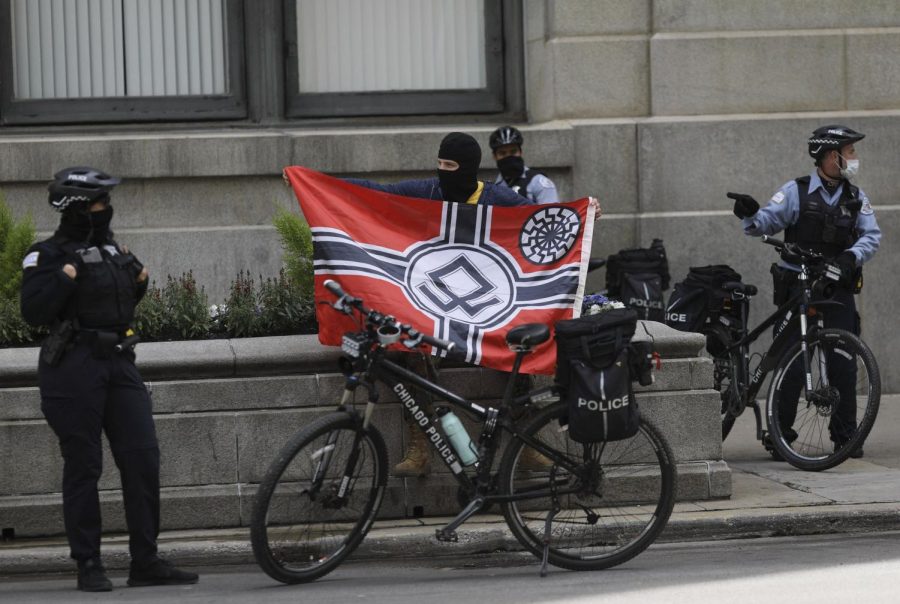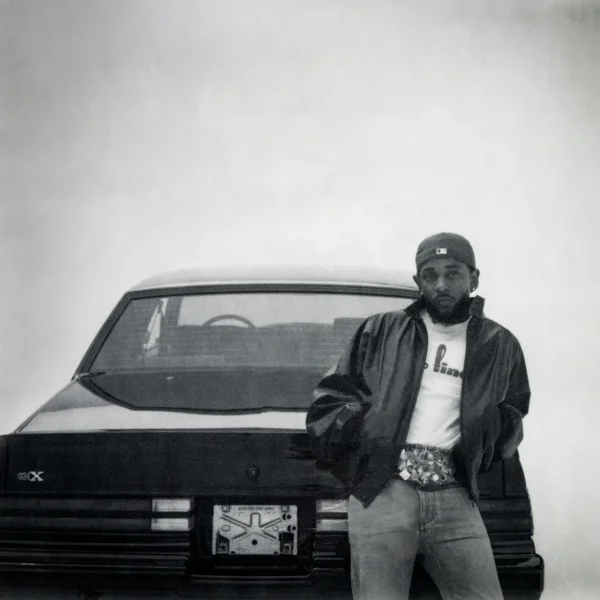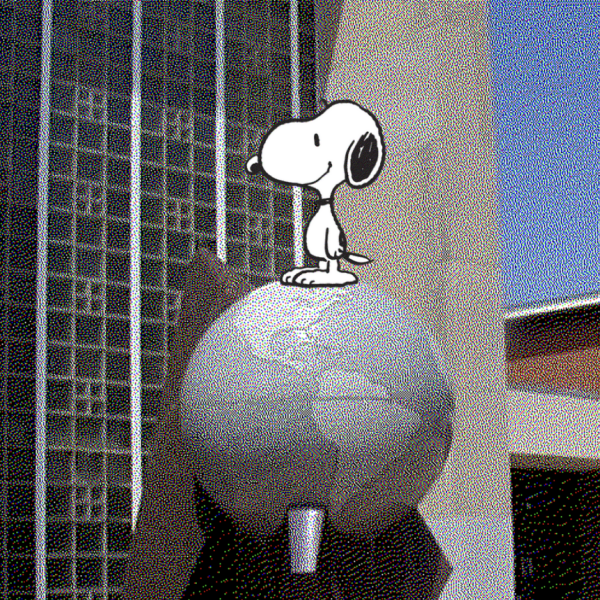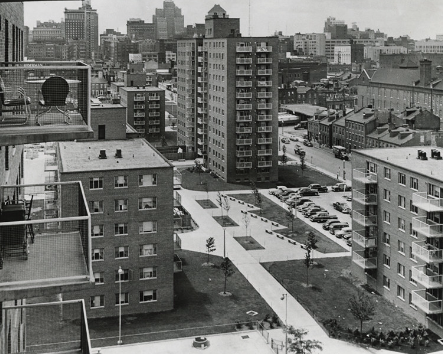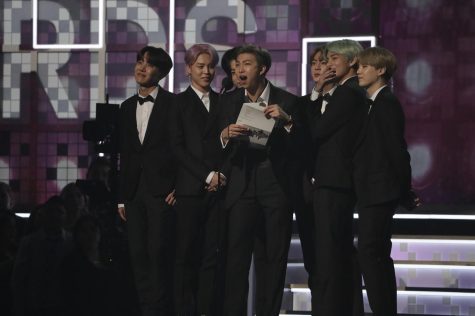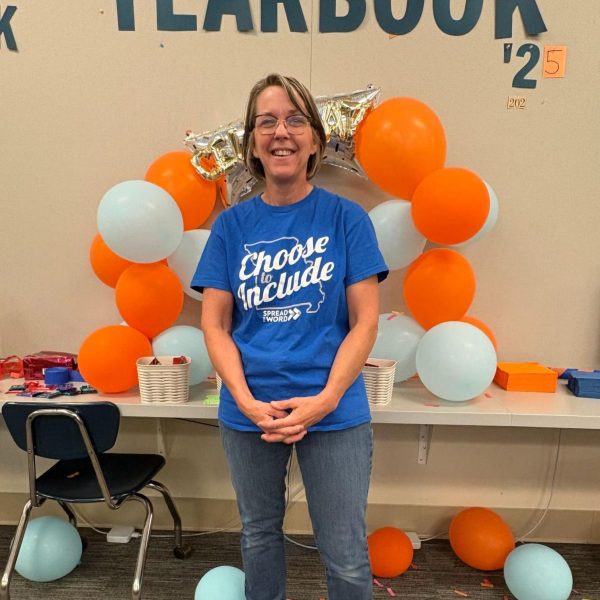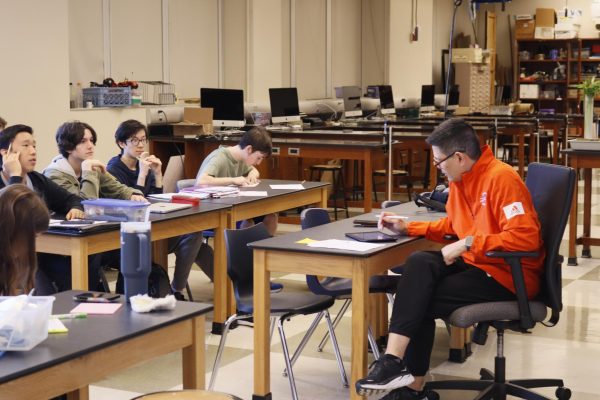The Rise in Antisemitism
With reports of antisemitism at an all time high in schools, in the streets and on social media, millions of Jews fear for their lives and the safety of their families
A man with a ski mask is surrounded by police officers at a reopen Illinois rally outside Chicago’s Thompson Center, May 16, 2020. As the rally was winding down, he walked around with a banner with an apparent Neo-Nazi sign.
In Uman, Ukraine, a visibly Jewish man was attacked at a supermarket. In Austria, the head of Graz’s Jewish community was attacked with a wooden club. In Delaware, firefighters responded to a fire at the Chabad Center of the University of Delaware caused by an arson attack. In Boise, Idaho on Dec. 7, nine swastika stickers were placed throughout the Anne Frank Human Rights Memorial. Then, as Jewish families celebrated Hanukkah this year, several cases of antisemitism occurred throughout the country. On Dec. 13, a man chanted antisemitic remarks to a father and his son in Miami Beach, Florida. On Dec. 14 in Great Neck, New York, hackers infiltrated the website of the North Shore Hebrew Academy, posting swastikas, slurs, and Nazi videos.
Antisemitism has been on the rise globally, with a surge in vandalism and assaults against Jewish people and places of worship in the past several years. According to the Anti-Defamation League (ADL), there were more than 2,100 attacks of harassment, vandalism, and assaults across the United States in 2019 alone, the highest number since the ADL began recording hate crimes in 1979. According to a survey conducted by the organization in April 2020, two-thirds of American Jews feel less safe today than they did a decade ago.
For over a hundred years, the ADL has focused on stopping antisemitism by providing education not only to students, but also to educators, community groups, and corporations in an attempt to break down biases and stereotypes.
Karen Aroesty, regional director of the ADL, expresses how important education is to reject biases that are socialized in everyone. Many school districts lack a basic curriculum about racism, antisemitism, and in more broad terms, teaching kids to embrace other’s differences. “It’s not magic fairy dust, it’s education,” said Aroesty.
Only a little over two years ago, a gunman entered the Tree of Life synagogue in Pittsburgh, yelling “All Jews must die” as he opened fire among the congregants. The gunman killed eleven people and wounded six more, making the attack the deadliest killing of Jews in the United States on record.
“In all the ways in which the United States still is the safest country in the world for Jewish people, the most accepting, and the one that provides the greatest opportunity, we still have extraordinary levels of hate and violence that leave folks in the Jewish community understandably anxious,” said Aroesty.
These anti-Semitic attacks are alarming, but unfortunately not a novel concept. Jews have been attacked and persecuted for thousands of years. In the centuries before Christ, the Israelites experienced intermittent persecution for refusing to adopt the religion and worship the ideals of the kingdoms of the Middle East in which they lived. Initially, Christianity was seen as a Jewish sect, as Jesus and the disciples were Jewish. Later, however, Christians began to view Jews as the killers of Christ and a threat to Christians and Christianity.
Rabbi Susan Talve of Central Reform Congregation (CRC) in St. Louis, Missouri believes that Jews have been scapegoated for a long time.
“We’re a small people so we are easy to pick on. So when Hitler was looking for a scapegoat, blame the Jews, and not only blame the Jews but take their money, or you can take their wealth. That happened during the Spanish Inquisition, with the Catholic Church, and it happened again during the Holocaust. Because if you want to gain power, one of the ways to do that is to define a common enemy and the Jews are an easy scapegoat,” said Talve.
In schools, the history of religion, especially Judaism, is either not taught or not taught in its entirety. Talve stresses the importance of education about history and religion in schools as a way to tackle and prevent stereotypes about Judaism and other religions. “There will be no redemption without truth. There is no healing that can happen unless we first tell the truth about our past.”

She went on to explain that the lives of significant historical figures are often complicated, and what one person may view as a noble and holy person may have been a threat to others. “Louis the Ninth was no saint, for Jews or Muslims. The Catholics made him a saint because he fed poor white Christians, but he killed Jews and he killed Muslims and he burned all of our books and he plundered across Europe and Asia to get to Jerusalem. That’s who our city is named for,” said Talve.
History classes, especially throughout the United States, are often very eurocentric and place a large emphasis on the origins, development, and reformation of Christianity throughout Europe and the world, whereas the origins and principles of Judaism tend to be overlooked or brushed over quickly, indirectly instilling the idea that Judaism is insignificant in a world largely dominated by Christianity.
Stereotypes of Jewish people have existed for centuries, and they have often been represented as caricatures of a prejudiced nature. These stretch from the more egregious stereotypes of Jews as Christ-haters and Christ-killers to more banal injustices that ridicule common features or items associated with Jewishness, such as having a larger, hooked nose, playing the violin, or being of shorter stature.
Social media is one of the best and worst things to happen to this generation. With the rise of antisemitic remarks on popular apps such as Instagram, Facebook, and Tik Tok; disgusting remarks can be passed off as dark humor.
“Social media can be scary because things spread so quickly, misinformation can be like a virus. When mean people find other mean people on social media, they feed off of each other and it’s a very disgusting growth that occurs” said Benjamin Hochman, a columnist for the St. Louis Post Dispatch.
Although most Jewish students at Clayton feel safe and accepted, some students feel as though more should be added to the curriculum regarding antisemitism. “I feel very safe at Clayton High School as a Jewish student. In my experience, Clayton is an accepting community and the students acknowledge each other’s differences in religion. However, I do think we can develop our antisemitism curriculum, especially in History courses. Antisemitism spans further than a basic understanding of the Holocaust and our curriculum should reflect that,” CHS student Sophie* said.
“I think that antisemitism is taught, alongside many forms of hatred, as something a part of the past which it is not. It is important for people to know it existed long before the Holocaust and still exists today and is getting worse” said Izzy Erdmann, a sophomore at Clayton High School.
CRC was founded in 1984 by 30 people committed to social justice and the city of St. Louis. In 2000, they built their building to continue their commitment to those values. They have experienced threats and harassment in the years since it was built. Talve describes, “There are letters that we get, the hate mail that we get from people who think we’re going to Hell because we’re the wrong religion, people who think we’re not saved and who think we’re not adding to a better world.”
Talve argues that as the world becomes more educated and sensitized to the racism that Black people face, it is important to extend that same attitude towards antisemitism. “We are getting good at red flags when it comes to racism because we’re educating people. We have to do the same thing with antisemitism. When people say, ‘Jews have joint loyalty,’ that is one of those red flags. You have to begin to learn if you want to be an ally.”
In addition, some people who live close to CRC have made it difficult for the congregation to coexist.
“Our neighbors don’t like anybody who isn’t them. They don’t like Jews, they don’t like people that are Black, they don’t like people that are gay. But they certainly don’t like that we are next to them as a synagogue, and they tried to fight against that when we got the property” said Talve.
When Michael Brown was shot by a police officer in 2014, protests erupted in the streets of Ferguson pleading for justice in the police system of St. Louis. Talve stood with the protestors in the streets for almost a year. She says that the best way to combat antisemitism as a Rabbi is to make sure that everything that you do is done with sense and sensibility towards educating people what the essence of Judaism is.
“So that they don’t jump to their own conclusions and so they are forced to understand their explicit and implicit bias. The most important thing that I do is to enter into relationships with people who are outside of my comfort zone. The most important thing that I can do is to show up in places where I can live my Jewish values. Because then, people can’t stereotype me,” said Talve.
Talve believes that her being there pushes away the rhetoric that Jews do not care about others, which is a common stereotype. When Talve showed up in the streets of Ferguson to protest the killing of Michael Brown, she cared about the children, about the safety of the streets, and about the Jewish values she holds.
“I was there because Jewish values had told me to be there. The fact that I was there allowed for people to not turn the protests into anti-Jewish rhetoric. That happened. Again and again, there were people who tried to turn it into anti-Israeli solidarity with Palestine. There were reasons to make connections with Palestinian solidarity. But when I was there, we could talk about the similarities of those connections and not allow people to turn it into an antisemitic event,” said Talve.
When you get out of your comfort zone and you let people get to know you, Talve believes that this is how you dispel stereotypes about Jews. When one sees the values in Judaism in a positive light, they are much less likely to be antisemitic. That also has to do with the way that schools talk about acceptance.
“Dialogue needs to be taught. How to talk to others. How to listen and understand what those civic values mean. Those values need to be practiced and taught. You get it taught to you in kindergarten, but you unlearn those values as time goes on. So how do we bring people together? How do you teach a common language? How do you teach people to really listen to each other?” asked Talve.
Rooting out antisemitism in one’s community also means realizing how normalized antisemitism is. In 2017, Chesed Shel Emeth Cemetery in University City was vandalized. A person threw rocks and toppled headstones. Jewish community centers receive threats, swastikas are planted on the sides of city subways, and Hasidic people are taunted and bullied in the streets of New York.
Antisemitism and racism are the products of hate and white fear, which has been accelerated by the knowledge that whites have begun to use their long-held privilege and will be in the minority in a few decades.
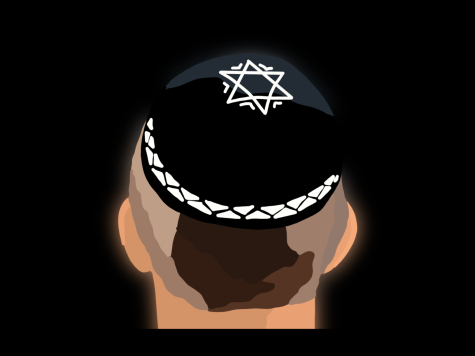
On January 6th, white supremacists and neo-nazis marched into the Capitol. A man among the crowd was wearing a “Camp Auschwitz” shirt, another man wearing a shirt that said “6MWE”, as in 6 million Jews killed during the Holocaust wasn’t enough. This was the first day that someone walked into the Capitol flying a confederate flag, a painful symptom of the disease of racism in the United States that has been spreading since its founding. Likewise, understanding antisemitism is the first step in understanding how to combat it and prevent it. Just as it is everyone’s job to root out racism in schools, universities, and the workplace, it is also everyone’s job to call out antisemitism and stand up for those who are looked over and subordinated in society.
Talve says, “As long as there are these kinds of divisions, there is always going to be antisemitism. It’s when we see antisemitism as the part of a much bigger story that we start to figure out how to live in the promised land together, where everybody has equity, where everybody is seen and everybody has infinite worth, and nobody gets to be called less human than anybody else”. Acceptance and equality will never come without truth and proper education.
A $50 or more donation includes a subscription to the Clayton High School Globe 2024-2025 print news magazine.
We will mail a copy of our issues to the recipients of your choice.
Your donation helps preserve the tangible experience of print journalism, ensuring that student voices reach our community and that student democracy thrives.
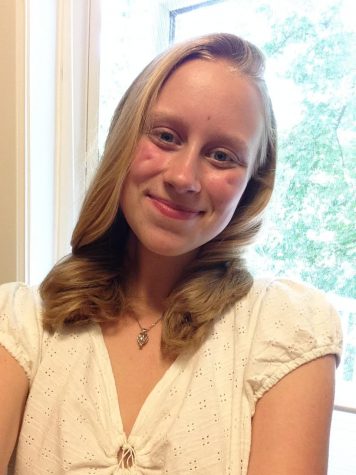
Seraphina Corbo is a junior at CHS who is a Senior Managing Editor on the Globe this year. From an early age, Seraphina always loved writing and hearing peoples' stories and opinions....

Kate is a senior at CHS and she is excited for her fourth year on the Globe. She is joining the Globe again this year as a Senior Managing Editor. In her free time, she plays tennis...


